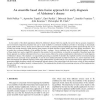Free Online Productivity Tools
i2Speak
i2Symbol
i2OCR
iTex2Img
iWeb2Print
iWeb2Shot
i2Type
iPdf2Split
iPdf2Merge
i2Bopomofo
i2Arabic
i2Style
i2Image
i2PDF
iLatex2Rtf
Sci2ools
INFFUS
2008
2008
An ensemble based data fusion approach for early diagnosis of Alzheimer's disease
As the number of the elderly population affected by Alzheimer's disease (AD) rises rapidly, the need to find an accurate, inexpensive and non-intrusive diagnostic procedure that can be made available to community healthcare providers is becoming an increasingly urgent public health concern. Several recent studies have looked at analyzing electroencephalogram (EEG) signals through the use of wavelets and neural networks. While showing great promise, the final outcomes of these studies have been largely inconclusive. This is mostly due to inherent difficulty of the problem, but also
Data Fusion Approach | INFFUS 2006 | INFFUS 2008 | Non-intrusive Diagnostic Procedure | Urgent Public Health |
| Added | 26 Jan 2011 |
| Updated | 26 Jan 2011 |
| Type | Journal |
| Year | 2008 |
| Where | INFFUS |
| Authors | Robi Polikar, Apostolos Topalis, Devi Parikh, Deborah Green, Jennifer Frymiare, John Kounios, Christopher M. Clark |
Comments (0)

